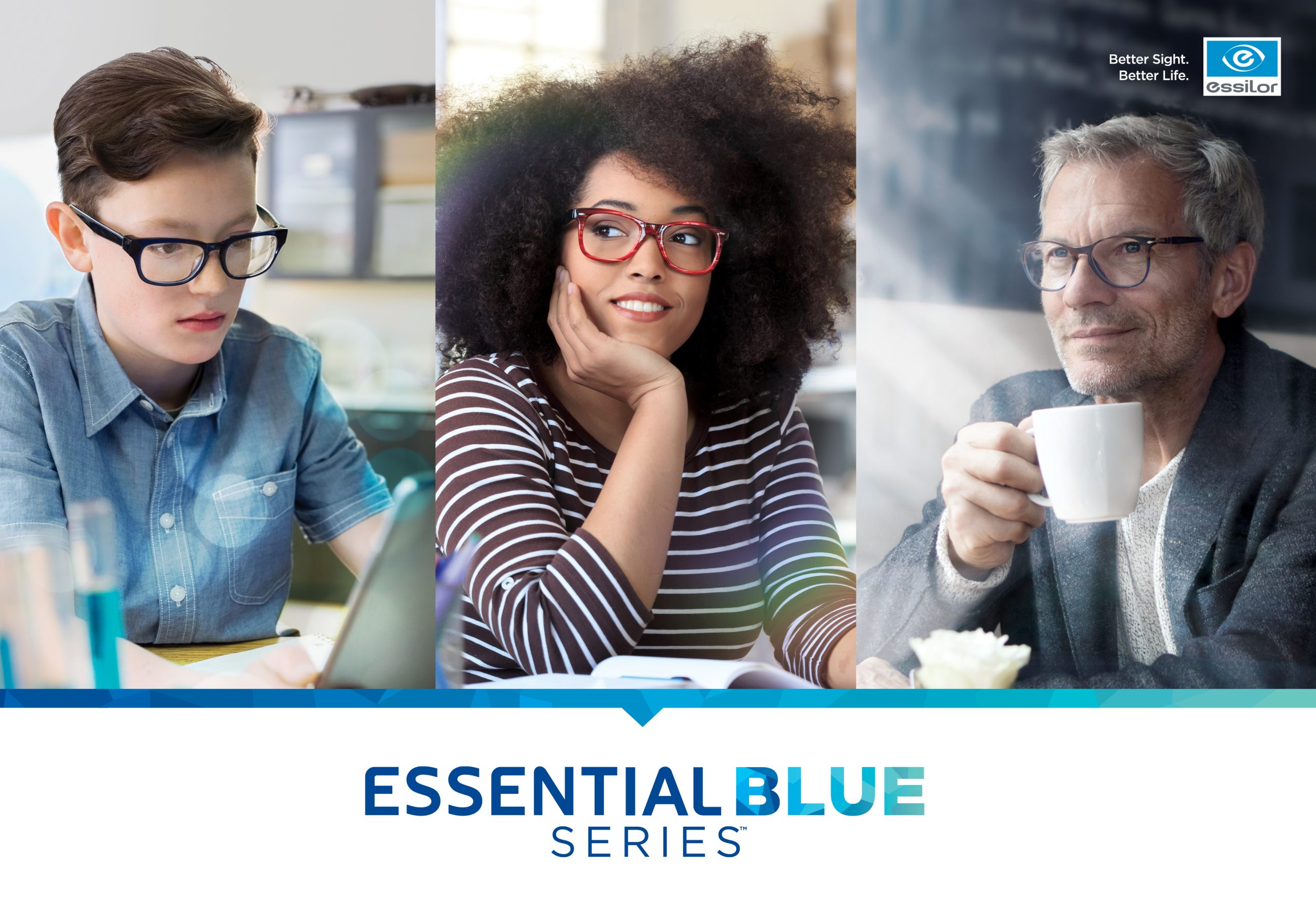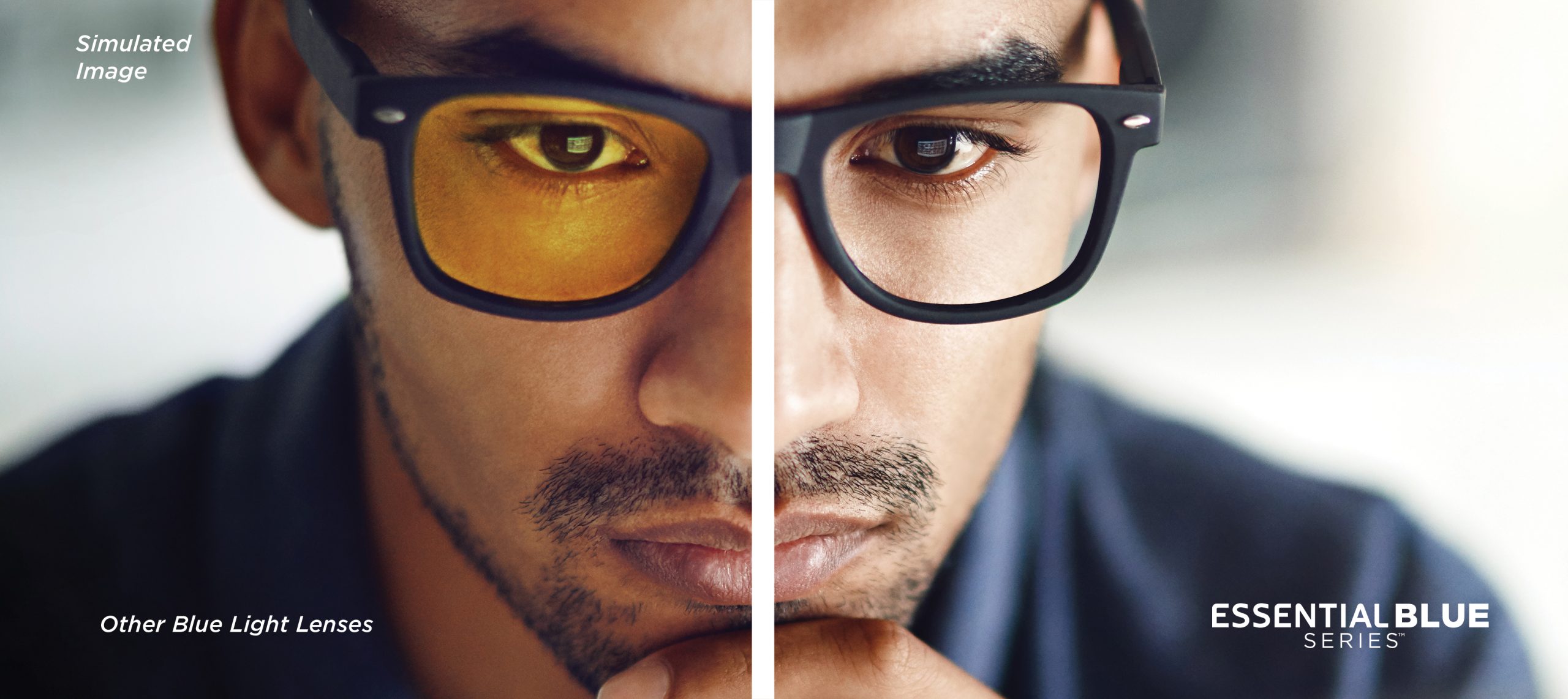Podcast: Play in new window | Download
Subscribe: Apple Podcasts | Google Podcasts | Spotify | Amazon Music | Android | RSS
This podcast was produced in partnership with our sponsor, Essilor.
The good news? The word is out about the harmful blue light; 88% of Americans report “light emitted from digital devices can negatively affect vision” in a 2017 AOA survey. Patients are coming into eye exams concerned about their risk and asking about solutions. The bad news? A lot of confusion and

misinformation pervades the conversation. We sit down with former optician and Senior Director of Professional Solutions at Essilor, Pete Hanlin, to separate myth from reality and discuss both the risks we need to communicate to patients, and the real benefits of prescribing blue light protection.
Truth: Not All Blue Light Is Bad
Many of our patients associate blue light protection with yellow tinted lenses, but blocking 100% of blue light has potential negative effects. Not only will yellow tinted lenses skew color perception, but they block transmission of blue wavelength light across the entire visible wavelength spectrum. Blue light in the range of 465-480 nanometers (often called Blue-Turquoise Light) is essential to our body’s regulation of circadian rhythm. In 1998 a new retinal photoreceptor names melanopsin was discovered, activated by blue wavelength light and essential to our internal circadian rhythm. It affects sleep/wake cycles and mood, and impacts release of melatonin, cortisol secretion, body temperature, heart rate, and alertness. When we prescribe blue light protection, we must use technology that can differentiate between the “good” longer wavelength blue light that is so essential to multiple layers of our body’s function.
The blue light our lens solutions should target specifically is the shorter wavelength light between 415-455 nanometers. This blue-violet high energy visible blue light (abbreviated HEV) is the harmful range that can impact retinal tissue. Mulitple in vitro studies have shown HEV blue light has the potential to cause retinal cell toxicity.
Truth: The Biggest Source of High Energy Blue Light is the Sun
Remember when your parents tried to explain to 4 year old you why the sky was blue? The sun is by far the largest source of our daily blue light exposure; blue light makes up 25-30 percent of daylight. In fact the blue light emitted by sunlight is at least 100 x greater than other artificial sources like LED lights or digital devices. When we prescribe for blue light protection, a great pair of sunglasses must top the list!

For many of our patients using devices for long hours, their eyes can feel sensitive and fatigued from the additional blue light exposure they are getting indoors. Essilor’s new Essential Blue Series is a visibly clear lens that blocks 3 x more HEV blue light than traditional clear lenses. Transitions lenses also block over 20% of indoor HEV blue light while inactivated indoors, with the added benefit of blocking over 85% of outdoor HEV blue light while activated (as well as being 100% UVA and UVB blocking).
Truth: Studies Demonstrate Multiple Benefits of Blue Light Protection
While the science of the associated risks between blue light exposure and retinal toxicity in vivo in humans is ongoing, there have been correlational studies in humans that raise major concerns:
A 2015 study comparing patients with yellow-tinted IOLs (blue blocking) versus clear IOLs showed a statistically significant higher incidence of age-related macular degeneration in patients with clear IOLs two years post-operatively.
Additionally, HEV blue light protection has shown vision benefits. In a 2017 study, patients with reduced best corrected acuity wearing blue blocker lenses showed statistically significant improvement versus clear lenses and yellow tinted lenses on contrast sensitivity and glare testing. Short wavelength HEV light has higher incidence of scatter, so by selectively blocking wavelength at that spectrum, you can improve your patient’s ability to see in more difficult low contrast situations, like driving at night facing oncoming headlight glare!
And HEV blue light exposure is a chief offender in subjective visual disturbances. Not only has it been linked to light sensitivity and digital eye strain symptoms like “tired eyes,” the incidence of transient unilateral visual disruption is on the rise. Dubbed “smart phone blindness,” patients lying in bed looking at their cell phone at night can experience lasting dimness of vision into the morning hours in the eye contralateral to the side they were laying on in the bed. While this condition is benign and clarity will return to the patient without lasting impact as the day goes on, prescribing for solutions to this increasingly common complaint can improve our patient’s daily visual function, as well as reduce unnecessary stress or anxiety they may be suffering over the fear of going blind.

What solutions do you prescribe? To learn more about the next generation of visibly clear lenses with selective HEV blue blocking benefits, check out the Essilor Essential Blue Series. This great YouTube video shows the Essential Blue Series at work, perfect for patient education in your optical or in email newsletters to communicate the benefits you can provide to your patients.



I appreciate Pete’s comments and education. While I agree with much of what was stated, it is important to address the issue of longer wavelength blue light in terms of how it impacts sleep for many individuals. Of course, just avoiding the use of digital devices at night is a good start, but many of the other light sources in our lives (low energy, high Kelvin lighting) will still affect us at night. This is why it is important to offer a solution for addressing the longer wavelengths of blue light at night, for those who use digital devices at night, watch LED TV, or are otherwise exposed to bright long wavelengths of blue (455-490nm.)